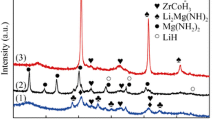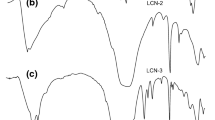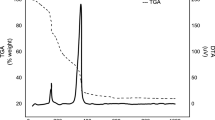Abstract
The catalytic effects of ZrC powder on the dehydrogenation properties of LiAlH4 prepared by designed mixing processes were systematically investigated. The onset dehydrogenation temperatures for the 10 mol% ZrC-doped sample are 85.3 and 148.4 °C for the first two dehydrogenation stages, decreasing by 90.7 and 57.8 °C, respectively, compared with those of the as-received LiAlH4. The isothermal volumetric measurement indicates that adding ZrC powder could significantly enhance the desorption kinetics of LiAlH4. The reaction constant and Avrami index show that the first dehydrogenation stage is controlled by diffusion mechanism with nucleation rate gradually decreasing and the second stage is a freedom nucleation and subsequent growth process. The microstructures and phase transformation characterized by scanning electron microscopy (SEM), X-ray diffraction (XRD), X-ray photoelectron spectroscopy (XPS) and Fourier transform infrared spectroscopy (FTIR) reveal that the improved desorption behavior of LiAlH4 is primarily due to the high density of surface defects and embedded catalyst particles on the surface of LiAlH4 particles during the high-energy mixing process.







Similar content being viewed by others
References
Li Y, Tao Y, Huo Q. Effect of stoichiometry and Cu-substitution on the phase structure and hydrogen storage properties of Ml–Mg–Ni-based alloys. Rare Met. 2015;22(1):86.
Li LG, Li SF, Tan YB, Tang ZW, Cai WY, Guo YH, Li Q, Yu XB. Hydrogen generation from hydrolysis and methanolysis of guanidinium borohydride. J Phys Chem C. 2012;116(27):14218.
Li P, Li ZL, Zhai FQ, Wan Q, Li XQ, Qu XH, Volinsky AA. NiFe2O4 Nanoparticles catalytic effects of improving LiAlH4 dehydrogenation properties. J Phys Chem C. 2013;117(49):25917.
Zheng XP, Zheng JJ, Ma QH, Liu SL, Feng X, Lin XB, Xiao G. Study on dehydrogenation properties of the LiAlH4–NH4Cl system. J Alloys Compd. 2013;551:508.
Li ZL, Zhai FQ, Wan Q, Liu ZJ, Shan JW, Li P, Volinsky AA, Qu XH. Enhanced hydrogen storage properties of LiAlH4 catalyzed by CoFe2O4 nanoparticles. RSC Adv. 2014;4:18989.
Wan Q, Li P, Li ZL, Zhao KF, Liu ZW, Wang L, Zhai FQ, Qu XH, Volinsky AA. NaAlH4 dehydrogenation properties enhanced by MnFe2O4 nanoparticles. J Power Sources. 2014;248:388.
Bogdanovic B, Schwickardi M. Ti-doped alkali metal aluminium hydrides as potential novel reversible hydrogen storage materials. J Alloys Compd. 1997;253–254:1.
Andreasen A, Veggea T, Pedersena AS. Dehydrogenation kinetics of as-received and ball-milled LiAlH4. J Solid State Chem. 2005;178(12):3672.
Langmi HW, McGrady GS, Liu XF, Jensen CM. Modification of the H2 desorption properties of LiAlH4 through doping with Ti. J Phys Chem C. 2010;114(23):10666.
Balema VP, Pecharsky VK, Dennis KW. Solid state phase transformations in LiAlH4 during high-energy ball-milling. J Alloys Compd. 2000;313(1–2):69.
Varin RA, Zbroniec L. Decomposition behavior of unmilled and ball milled lithium alanate (LiAlH4) including long-term storage and moisture effects. J. Alloys Compd. 2010;504(1):89.
Vittetoe AW, Niemann MU, Srinivasan SS, McGrath K, Kumar A, Goswami DY. Destabilization of LiAlH4 by nanocrystalline MgH2. Int J Hydrogen Energy. 2009;34(5):2333.
Mao JF, Guo ZP, Leng HY, Wu Z, Guo YH, Yu XB, Liu HK. Reversible hydrogen storage in destabilized LiAlH4−MgH2−LiBH4 ternary-hydride system doped with TiF3. J Phys Chem C. 2010;114(26):11643.
Ismail M, Zhao Y, Yu XB, Dou SX. Effect of different additives on the hydrogen storage properties of the MgH2–LiAlH4 destabilized system. RSC Adv. 2011;1:408.
Wan Q, Li P, Li ZL, Zhai FQ, Qu XH, Volinsky AA. Improved hydrogen storage performance of MgH2–LiAlH4 composite by addition of MnFe2O4. J Phys Chem C. 2013;117(51):26940.
Resan M, Hampton MD, Lomness JK, Slattery DK. Effects of various catalysts on hydrogen release and uptake characteristics of LiAlH4. Int J Hydrogen Energy. 2005;30(13–14):1413.
Hima KL, Viswanathan B, Srinivasa MS. Dehydriding behaviour of LiAlH4-the catalytic role of carbon nanofibers. Int J Hydrogen Energy. 2008;33(1):366.
Rafi UD, Zhang L, Li P, Qu XH. Catalytic effects of nano-sized TiC additions on the hydrogen storage properties of LiAlH4. J Alloys Compd. 2010;508(1):119.
Li ZL, Li P, Wan Q, Zhai FQ, Liu ZW, Zhao KF, Wang L, Lv SY, Zou L, Qu XH, Volinsky AA. Dehydrogenation improvement of LiAlH4 catalyzed by Fe2O3 and Co2O3 nanoparticles. J Phys Chem C. 2013;117(36):18343.
Pang YP, Liu YF, Gao MX, Ouyang LZ, Liu JW, Wang H, Zhu M, Pan HG. A mechanical-force-driven physical vapor deposition approach to fabricating complex hydride nanostructures. Nature Commun. 2014;5:3519.
Wahab MA, Beltramini JN. Catalytic nanoconfinement effect of in situ synthesized Ni-containing mesoporous carbon scaffold (Ni–MCS) on the hydrogen storage properties of LiAlH4. Int J Hydrogen Energy. 2014;39(32):18280.
Chumphongphan S, Fils U, Paskevicius M, Sheppard DA, Jensen TR, Buckley CE. Nanoconfinement degradation in NaAlH4/CMK-1. Int J Hydrogen Energy. 2014;39(21):11103.
Jongh PE, Allendorf M, Vajo JJ, Zlotea C. Nanoconfined light metal hydrides for reversible hydrogen storage. MRS Bull. 2013;38(6):488.
Rangsunvigit P, Purasaka P, Chaisuwan T, Kitiyanan B, Kulprathipanja S. Effects of carbon-based materials and catalysts on the hydrogen desorption/absorption of LiAlH4. Chem Lett. 2012;41(10):1368.
Orimo S, Nakamori Y, Eliseo JR, Zuttel A, Jensen CM. Complex hydrides for hydrogen storage. Chem Rev. 2007;107(10):4111.
Varin RA, Parviz R. The effects of the micrometric and nanometric iron (Fe) additives on the mechanical and thermal dehydrogenation of lithium alanate (LiAlH4), its self-discharge at low temperatures and rehydrogenation. Int J Hydrogen Energy. 2012;37(11):9088.
Rafi UD, Qu XH, Li P, Zhang L, Ahmad M. Hydrogen sorption improvement of LiAlH4 catalyzed by Nb2O5 and Cr2O3 nanoparticles. J Phys Chem C. 2011;115(26):13088.
Zheng XP, Li P, Humail IS, An FQ, Wang GQ, Qu XH. Effect of catalyst LaCl3 on hydrogen storage properties of lithium alanate (LiAlH4). Int J Hydrogen Energy. 2007;32(18):4957.
Liu XF, Beattie SD, Langmi HW, McGrady GS, Jensen CM. Ti-doped LiAlH4 for hydrogen storage: rehydrogenation process, reaction conditions and microstructure evolution during cycling. Int J Hydrogen Energy. 2012;37(3):10215.
Liu XF, McGrady GS, Langmi HW, Jensen CM. Facile cycling of Ti-doped LiAlH4 for high performance hydrogen storage. J Am Chem Soc. 2009;131(14):5032.
Liu XF, Langmi HW, Beattie SD, Azenwi FF, McGrady GS, Jensen CM. Ti-doped LiAlH4 for hydrogen storage: synthesis, catalyst loading and cycling performance. J Am Chem Soc. 2011;133(39):15593.
Kojima Y, Kawai Y, Matsumoto M, Haga T. Hydrogen release of catalyzed lithium aluminum hydride by a mechanochemical reaction. J Alloys Compd. 2008;462(1–2):275.
Ahmad M, Rafi UD, Pan CF, Zhu J. Investigation of hydrogen storage capabilities of ZnO-based nanostructures. J Phys Chem C. 2010;114(6):2560.
Li ZB, Liu SS, Si XL, Zhang J, Jiao CL, Wang S, Liu S, Zou YJ, Sun LX, Xu F. Significantly improved dehydrogenation of LiAlH4 destabilized by K2TiF6. Int J Hydrogen Energy. 2012;37(4):3261.
Bazzanella N, Checchetto R, Miotello A. Catalytic effect on hydrogen desorption in Nb-doped microcrystalline MgH2. Appl Phys Lett. 2004;85:5212.
Mintz MH, Zeiri Y. Hydriding kinetics of powders. J Alloys Compd. 1995;216(2):159.
Woldt E. The relationship between isothermal and non-isothermal description of Johnson–Mehl–Avrami–Kolmogorov kinetics. J Phys Chem Solids. 1992;53(4):521.
McCarty M, Maycock JN, Verneker VRP. Thermal decomposition of lithium aluminum hydride. J Phys Chem. 1968;72(12):4009.
Andreasen A. Effect of Ti-doping on the dehydrogenation kinetic parameters of lithium aluminum hydride. J Alloys Compd. 2006;419(1–2):40.
Ismail M, Zhao Y, Yu XB, Dou SX. Effects of NbF5 addition on the hydrogen storage properties of LiAlH4. Int J Hydrogen Energy. 2010;35(6):2361.
Ismail M, Zhao Y, Yu XB, Nevirkovets IP, Dou SX. Significantly improved dehydrogenation of LiAlH4 catalysed with TiO2 nanopowder. Int J Hydrogen Energy. 2011;36(14):8327.
Zhai FQ, Li P, Sun AZ, Wu S, Wan Q, Zhang WN, Li YL, Cui LQ, Qu XH. Significantly improved dehydrogenation of LiAlH4 destabilized by MnFe2O4 nanoparticles. J Phys Chem C. 2012;116(22):11939.
Ares JR, Aguey-Zinsou KF, Porcu M, Sykes JM, Dornheim A, Klassen T, Bormann R. Thermal and mechanically activated decomposition of LiAlH4. Mater Res Bull. 2008;43(5):1263.
Liu SS, Zhang Y, Sun LX, Zhang J, Zhao JN, Xu F, Huang FL. The dehydrogenation performance and reaction mechanisms of Li3AlH6 with TiF3 additive. Int J Hydrogen Energy. 2010;35(10):4554.
Talyzin AV, Sundqvist B. Reversible phase transition in LiAlH4 under high-pressure conditions. Phys Rev B. 2004;70:180101.
Chang R, Graham LJ. Low-temperature elastic properties of ZrC and TiC. J Appl Phys. 1966;37:3778.
Alward JF, Pong CY. Band structures and optical properties of two transition-metal carbides-TiC and ZrC. Phys Rev B. 1975;12:1105.
Acknowledgments
This work was financially supported by the National High Technology Research and Development Program of China (No. 2006AA05Z132) and the National Natural Science Foundation of China (No. 51471054).
Author information
Authors and Affiliations
Corresponding author
Rights and permissions
About this article
Cite this article
Li, ZL., Zhai, FQ., Qiu, HC. et al. Dehydrogenation characteristics of ZrC-doped LiAlH4 with different mixing conditions. Rare Met. 39, 383–391 (2020). https://doi.org/10.1007/s12598-016-0711-x
Received:
Revised:
Accepted:
Published:
Issue Date:
DOI: https://doi.org/10.1007/s12598-016-0711-x




